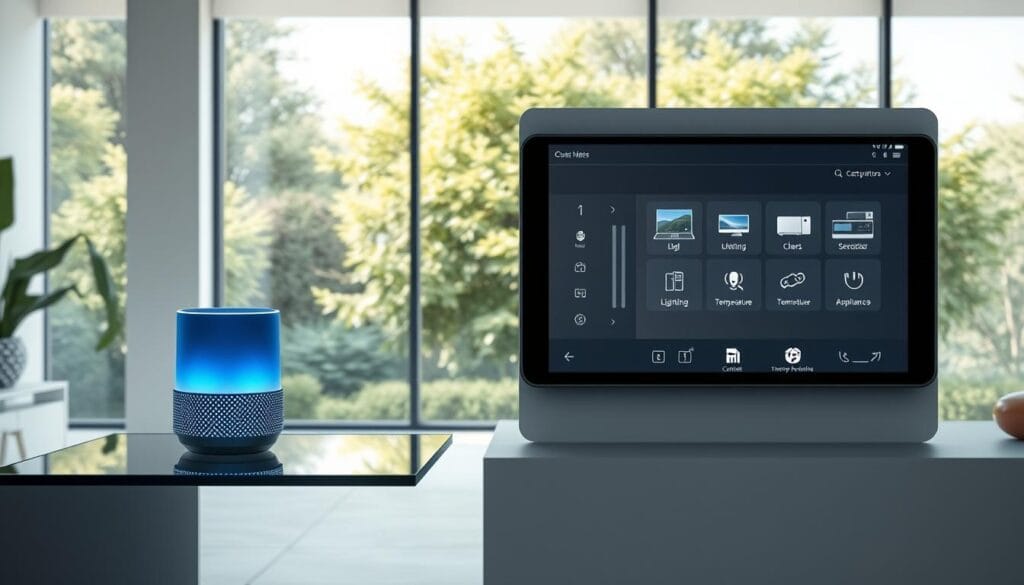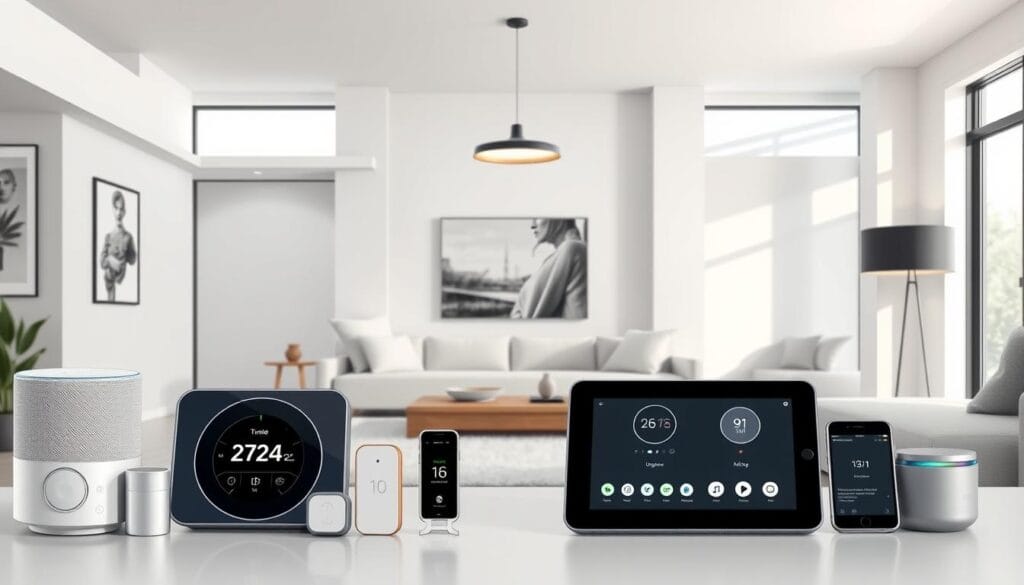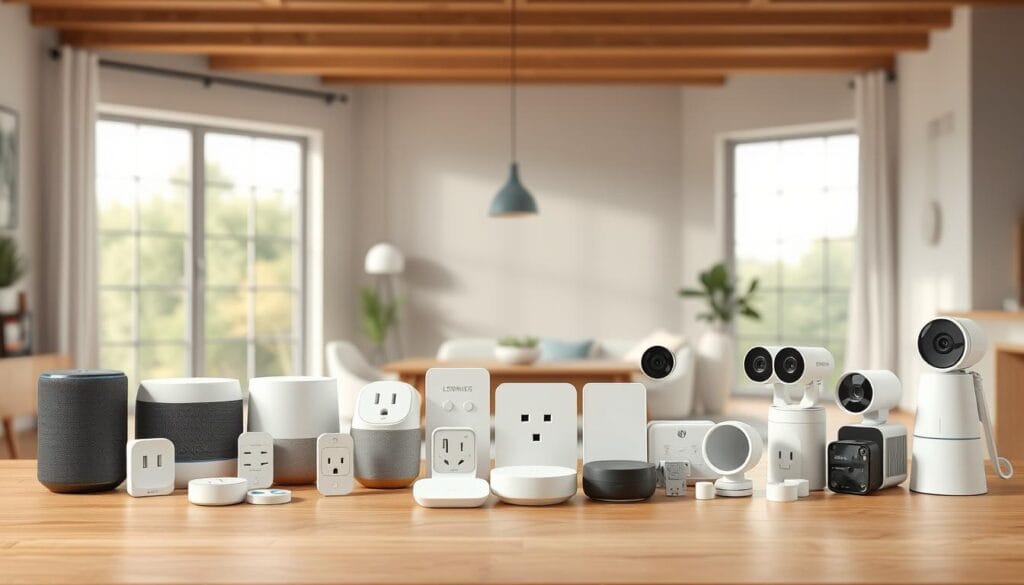
Are you ready to turn your home into a smart sanctuary? Imagine a space that knows what you need, saves energy, and makes life easier. This is what AI-powered home automation can do for you.
Technology is getting better, making smart homes easier to set up. I started exploring home automation to see how it could simplify my life.
In this guide, we’ll dive into the world of AI-powered homes. We’ll look at the latest tech, key components, and how to set it all up. You’ll learn how to make your home smarter and easier to live in.
Key Takeaways
- Discover the fundamental components of AI-powered home automation
- Learn how to select the right smart home devices for your needs
- Understand the basics of device compatibility and integration
- Explore energy-saving and security benefits of smart home technology
- Get started with beginner-friendly automation strategies
Understanding AI Powered Home Automation Fundamentals
AI-powered home automation is changing how we live. The smart home market is expected to grow from $81 billion in 2022 to $338.28 billion by 2030. This shows the big role of smart tech in our homes.
Home automation mixes artificial intelligence with smart tech for better living. It uses smart devices and AI to make our lives easier and our homes more functional.
Key Components of Smart Home Systems
- Central hub for device communication
- Wireless network infrastructure
- Smart sensors and IoT devices
- AI-powered control software
Benefits of AI Integration
AI makes home automation more personal and efficient. Real estate companies say 90% of residents love AI home apps.
| AI Benefit | Impact |
|---|---|
| Energy Management | Reduce energy waste by 30% |
| Security Enhancement | Decrease false alarms by 85% |
| Personalization | Adapt to individual preferences |
Basic Infrastructure Requirements
To build a strong smart home, you need fast internet, compatible devices, and a smart hub. Good infrastructure is key for smooth AI and smart tech integration.
As AI grows, home automation gets better and more available. It promises a future where our homes meet our needs and likes automatically.
Choosing the Right Smart Home Platform

Choosing the right automation platform can turn your home into a smart, efficient space. I’ll guide you through the world of voice control systems and smart home ecosystems. This will help you find the perfect fit for your needs.
When looking at automation platforms, you’ll find several top choices:
- Amazon Alexa
- Google Home
- Apple HomeKit
- Samsung SmartThings
Each platform has its own strengths. Amazon Alexa is known for its wide device compatibility and advanced automation. It supports Zigbee, Matter, and Amazon Sidewalk, making it great for smart home fans.
Google Home is perfect for those in the Pixel and Nest ecosystems. Its strength is in tight integration with Google services and support for the Matter standard. This allows devices from different platforms to talk to each other.
When choosing your automation platform, consider these key points:
- Device compatibility
- Ecosystem integration
- Voice control system capabilities
- Future expansion potential
Apple HomeKit is known for its strong security and integration with Apple products. It’s ideal for those deeply invested in the Apple ecosystem. It offers comprehensive home automation with complex routing options.
The Matter standard is emerging and aims to bridge gaps between different voice control systems. This gives users more freedom to choose devices from various manufacturers.
Pro tip: Consider your existing devices and ecosystem before making a final decision.
For practical advice, consider devices like the Amazon Echo (4th Gen) for Alexa users. Google Nest Audio is great for Google Home fans. The August Smart Lock Pro is good for those wanting support across multiple platforms.
Essential Smart Devices for Beginners
Starting your smart home journey can feel overwhelming. But don’t worry, I’m here to guide you. The right devices can turn your home into a smart, responsive space. It makes daily tasks easier and makes your home more comfortable.

Smart Speakers and Voice Assistants
Voice assistants are key to any smart home. The Amazon Echo (4th gen) is a great starting point. It has powerful sound and supports Zigbee at just $100. With Alexa, you can control many devices just by talking to it.
- Amazon Echo (4th gen): Central hub for voice control
- Google Nest Hub (2nd gen): 7-inch display with advanced features
- Supports multiple voice assistant platforms
Smart Lighting Solutions
Smart lighting makes your home more convenient and saves energy. The TP-Link Kasa Smart Plug Mini is a budget-friendly option at just $15. It lets you control traditional lamps and appliances with Wi-Fi.
Connected Security Devices
Smart security makes protecting your home easier. The August Wi-Fi Smart Lock offers top-notch security with virtual keys. It works well with Alexa, Google Assistant, and Siri.
| Device | Price | Key Features |
|---|---|---|
| Arlo Pro 5S Outdoor Camera | $79 | 2K resolution, floodlight, motion tracking |
| August Wi-Fi Smart Lock | $128 | Virtual key, voice assistant integration |
Choosing these smart devices will help you build a connected home ecosystem. It boosts convenience and security. Start with the basics and add more as you get more comfortable with the tech.
Network Setup and Connectivity Requirements

Building a strong network is key for a smart home. Your IoT devices need reliable, secure connections to work well. I’ll show you how to set up a network for smooth home automation.
Choosing the right internet plan is important for your smart home. Most smart homes need at least 100 Mbps download speed. For homes with lots of IoT devices, get a plan with 200 Mbps or more for better performance.
Network Optimization Strategies
- Select a dual-band or tri-band router for better coverage
- Think about mesh Wi-Fi systems for bigger homes
- Use wired connections for important devices
- Turn on WPA3 encryption for better security
Internet Speed Requirements
| Device Density | Recommended Speed | Performance Level |
|---|---|---|
| Minimal Smart Devices | 50-100 Mbps | Basic Functionality |
| Moderate Smart Home | 100-200 Mbps | Smooth Performance |
| Advanced IoT Setup | 200+ Mbps | High-Performance Automation |
When setting up your smart home network, security is crucial. Use a firewall, update your router often, and make separate networks for IoT devices. This will protect your digital world.
Remember, network needs will change over time. Keep up with new tech to keep your smart home running smoothly and efficiently.
Voice Control Systems and AI Assistants Integration
Voice control systems have changed how we interact with our homes. Intelligent assistants like Amazon Alexa, Google Assistant, and Apple’s Siri make home automation easy and hands-free. My experience with voice-controlled home technology has been amazing.
Today’s intelligent assistants do more than just take voice commands. They handle many parts of our home life with great accuracy:
- Control lighting and temperature
- Play music and manage entertainment systems
- Set reminders and schedule tasks
- Enhance home security
Popular Voice Assistant Platforms
There are three main platforms for voice control systems:
- Amazon Alexa: Works with many devices
- Google Assistant: Understands natural language well
- Apple Siri: Integrates well with Apple products
Setting Up Voice Commands
Setting up voice commands is easy. Most assistants have apps that help you connect devices and set commands. They learn your preferences and how you speak over time.
Creating Custom Voice Routines
Creating custom voice routines is the coolest part. Say “Good morning” and your home lights up, coffee starts brewing, and your schedule is read. Voice control systems make this simple, turning your home into a smart, responsive space.
Energy Management and Cost Optimization

Smart home automation platforms are changing how we handle energy use. AI-powered systems help cut down on utility bills and make homes greener.
Now, smart tech lets us track and tweak our energy use with ease. IoT smart meters send live data, so we can manage our electricity better than ever.
- Smart thermostats learn what we like
- Real-time monitoring spots energy waste
- AI gives us tips to save energy
My research shows a few main ways to save energy:
| Technology | Energy Savings Potential | Key Benefits |
|---|---|---|
| Smart Thermostats | 10-15% reduction | Adaptive temperature control |
| Energy Monitoring Systems | 20-30% reduction | Detailed consumption insights |
| Battery Storage | 25-40% grid independence | Peak demand management |
Automation platforms help homeowners cut down on energy waste. Schneider Electric’s Wiser system shows how smart solutions can change energy management. It offers real-time monitoring and smart load control.
The future of saving energy is here, thanks to AI and smart tech. It makes saving energy simpler and more effective than ever.
Advanced Automation Routines and Scheduling
To take your smart home to the next level, learn about advanced automation. Remote monitoring and smart scheduling change how we use our homes.
Today’s smart home systems are very flexible. They can learn and adjust to your life, making your home more efficient.
Creating Time-Based Automations
Smart scheduling lets you set up actions at specific times. Machine learning helps your system plan and do complex tasks on its own.
- Set daily wake-up sequences that gradually increase lighting
- Automatically adjust thermostats based on time of day
- Schedule security system activations during specific hours
Sensor-Triggered Actions
Advanced smart homes use sensors to respond to changes. They can react quickly to different situations.
| Sensor Type | Potential Automation |
|---|---|
| Motion Sensors | Activate lighting, adjust temperature |
| Temperature Sensors | Trigger HVAC system adjustments |
| Light Sensors | Automatically manage window shades |
Location-Based Controls
Now, smart homes can track your location. They can get ready for you before you even get home.
- Activate home security when you leave
- Adjust interior temperature before arrival
- Prepare entertainment systems based on your location
Using these advanced features, your home becomes smarter and more responsive. It will meet your needs without you asking.
Security and Privacy Considerations
Keeping your smart home safe is key. With new tech, knowing the risks is important for keeping your data safe.
Here are some privacy tips for AI-powered homes:
- Secure your Wi-Fi network with strong passwords
- Enable two-factor authentication on all devices
- Regularly update device firmware
- Review and limit data collection permissions
Smart devices gather a lot of personal info. Audio and visual data can be misused if not handled right. Laws like the California Consumer Privacy Act (CCPA) and Federal Trade Commission (FTC) are working to protect your data.
Choose home security systems that offer:
- Local data storage options
- End-to-end encryption
- Clear privacy policies
- Control over data collection
AI can make your home safer by cutting down on false alarms. Voice recognition is a good choice for security, as it’s less invasive than facial recognition.
Privacy is not a luxury, but a fundamental right in our connected world.
Stay informed and take action to keep your smart home safe. This way, you can enjoy its benefits without worrying about your privacy.
Conclusion
My exploration of AI-powered home automation has opened up a world of possibilities. The smart home scene is always changing, bringing us closer to the future. It’s now possible to enjoy levels of convenience and efficiency that were once dreams.
AI goes beyond just controlling devices. It’s changing how we manage energy and keep our homes safe. Voice controls are getting smarter, security systems are learning, and personalization is becoming more natural.
The future of AI in homes is thrilling. It will predict our needs and make our homes better for us. This includes health monitoring, saving energy, and making our homes fit our unique needs.
If you’re starting your smart home adventure, remember that tech is always evolving. Stay curious, keep learning, and try out new things. The future of home tech is about making our lives easier, more efficient, and tailored to us.
FAQ
What is AI-powered home automation?
AI-powered home automation uses artificial intelligence to make your home smarter. It connects devices and learns your habits. This way, it automates tasks and offers personalized experiences.
Which smart home platform should I choose?
The right platform depends on your needs. Amazon Alexa, Google Home, and Apple HomeKit are top choices. Think about device compatibility, ease of use, and how well it fits with your tech.
What are the essential smart devices for beginners?
Start with a smart speaker or voice assistant. Then, add smart lights and connected security devices like cameras and locks. These make your home more convenient, save energy, and improve security.
How can I improve my home network for smart home devices?
Use Wi-Fi range extenders and consider a mesh network. Create a dedicated IoT network for better connectivity. Keep your network secure with strong passwords and updated firmware.
Are voice assistants difficult to set up?
No! Voice assistants like Amazon Alexa and Google Assistant are easy to set up. Just download an app, create an account, and follow simple steps.
How can smart home automation save energy?
Smart thermostats and energy monitoring systems can cut down energy use. AI analyzes your habits and suggests ways to save energy.
What are the security risks of smart home technology?
Risks include network vulnerabilities and data privacy issues. Secure your Wi-Fi, use two-factor authentication, and update firmware regularly. Choose reputable brands for safety.
Can I create custom automation routines?
Yes! Most platforms let you create custom routines. You can set up actions based on time, sensors, or location. This makes your home adapt to your needs.
How much does a smart home setup cost?
Prices vary based on your system’s complexity. You can start with basic devices for $100-$300. Many devices offer affordable options for beginners.
Do I need technical expertise to set up a smart home?
No technical skills are needed. Modern smart home tech is easy to use. Even beginners can set up a connected home environment.













